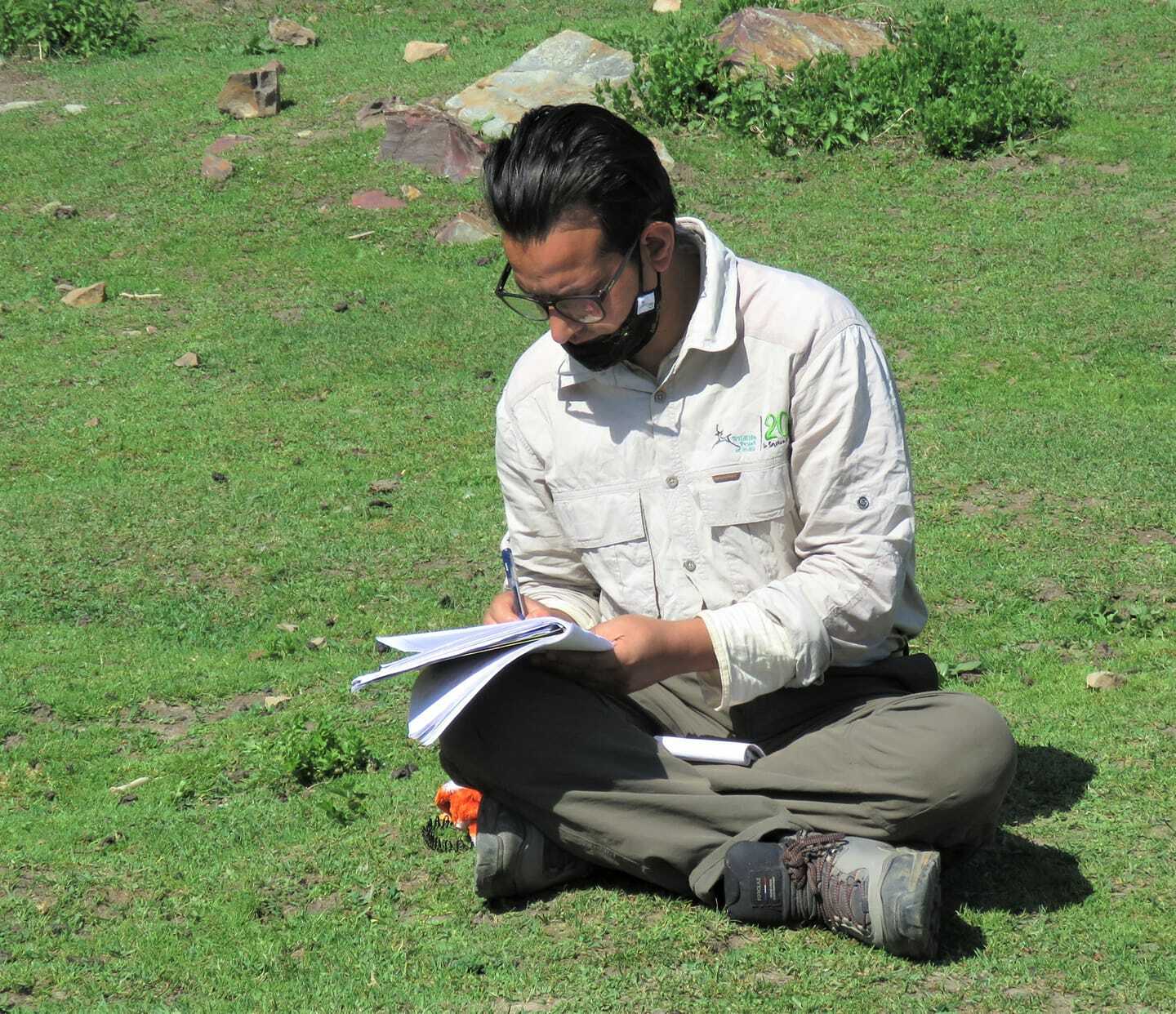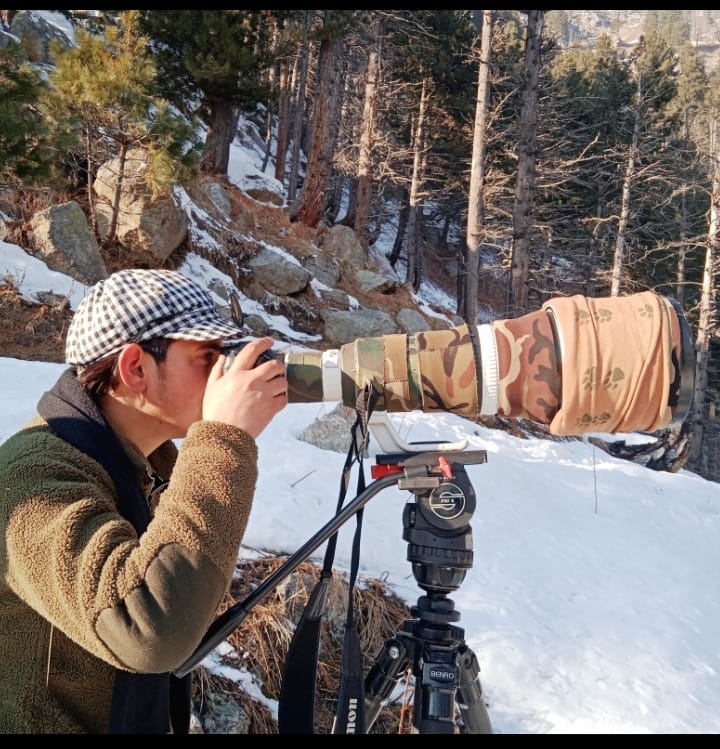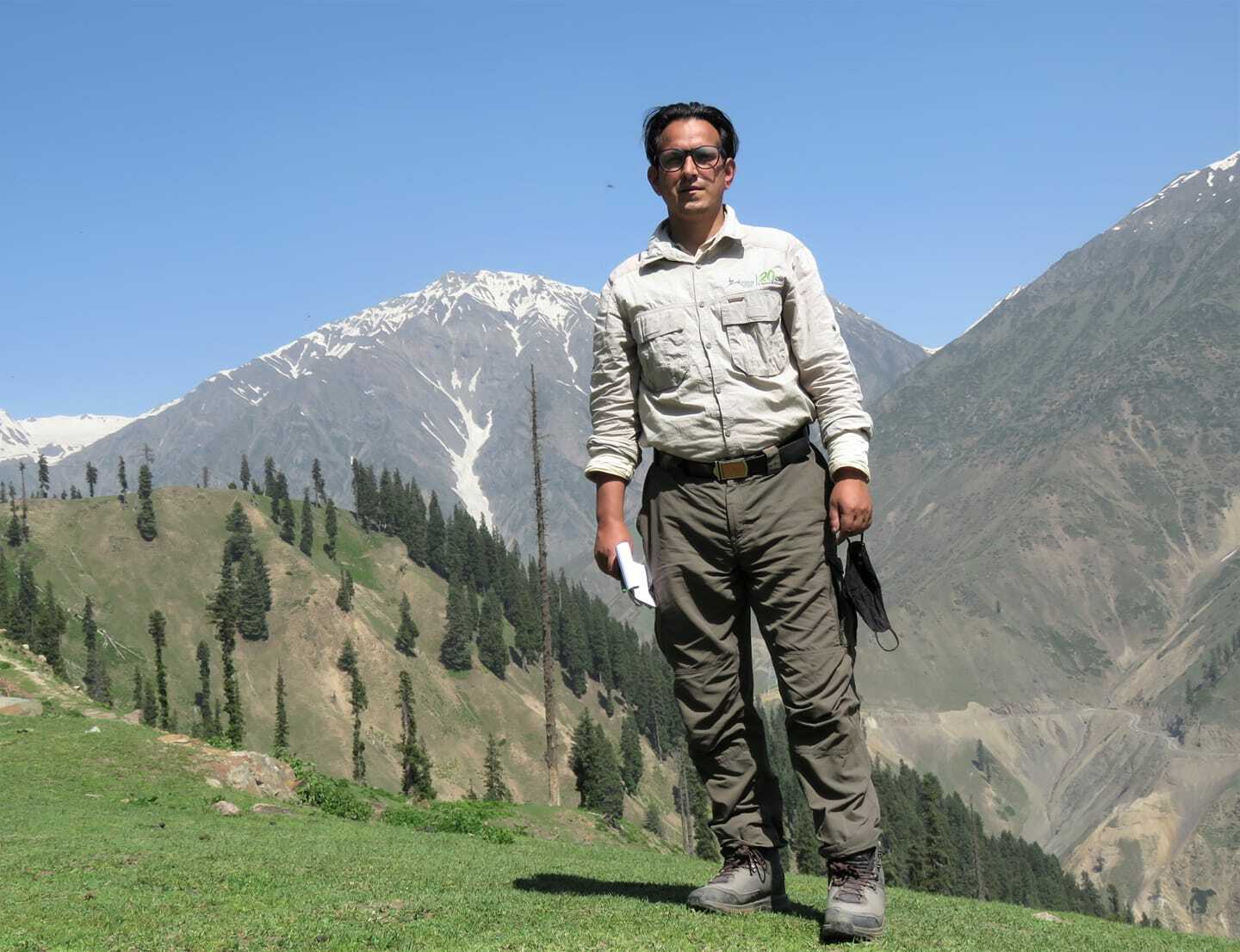 Sameer Khazir.
Sameer Khazir.
At a time when the growing man-wild conflict is sending all and sundry into a tizzy, a young wildlife officer has restored some order in Kashmir jungle with his scientific and the tribal-welfare methods.
IT was deep inside the wet forest, the sound of footsteps, embarked on a “coming of age” trip, was fleetingly dying-away on the carpet of leaves.
Few rangers, recruits and a sociologist walked for a few hours through Baramulla’s Kazinag National Park in complete silence, never speaking above a whisper.
They had set out from the base camp in the morning, carrying their backpacks stuffed with essentials, and traversed through the forest with every striking step.
As they walked past heavily mounted trees, the scout in front craned his neck towards the leafless crowns and scanned the landscape for signs of smugglers and poachers in the protected park. Footprints of boots in the moist land and half-smoked cigarette bits were there.
But that day, they weren’t parading against the poachers or timber smugglers. Except the sociologist, everyone else was clueless about their parade but kept on moving their feet as they had nothing else to do. They detested the trees for moving slowly against their progress. They had been walking for an hour.
As the parade was wearily moving their foot, a sociologist at the Wildlife Trust of India, Sameer Khazir, kept on marching triumphantly through the dusty road and neat-stone fences that were shaded by the bended bodies of the giant trees. He knew what he was doing and where he was heading towards — to the fringes of the sanctuary.
Proximate to the fringes, the arbitrarily placed Bakarwal sheds had started to appear, stretching a hopeful smile on Sameer’s face. The others were still clueless. “I knew that was an appropriate step to conserve Kazinag,” recalls Sameer.
The tribesmen from the eight herder families were alerted as soon as the sight of the leading scout was visible. For them, every person in a uniform is marching to boot them out of their ancestral residence. But, things turned calm when one of the elderly shouted, “It’s Sameer Sahib”.
 Sameer Khazir has earned the trust of tribals.
Sameer Khazir has earned the trust of tribals.
Unlike the raging reaction of native tribes against the forest officials, Sameer’s thoughtful character had saved him from the rage. “He’s one of the few who are respected by the tribesmen,” says Riyaz Ahmed, the sociologist’s colleague.
Sameer was conscious of Kazinag’s precarity. He had grown up in the vibrant mood of Baramulla town but had spent his youthful days in the forests, witnessing the illegal subdivision of the woods into small plots.
From one ridge inside the park, Sameer could see the disturbances that many of these herder families were bringing to the forest from their grazing activities.
It was about the same time, when he planned a meeting with senior government officials but all were too busy to interfere in the matter. There was nothing much he could have done.
“Kazinag is my home and the tribes living inside it are my family,” says Sameer. “I knew I was on my own in this mission of conservation of forests.”
In the effort to protect the Kazinag forest, Sameer was collaborating with the local tribesmen — a step that many termed “absurd”.
He had come up with a plan that would not only help to save the 250 Markhors of Kazinag National Park but would also help to save the forests.
“The plan was simple,” he says. “I requested them [tribesmen] to fill up a government scheme form that guaranteed them free LPG gas cylinders and burners. The same plan not only helped around 800 people of these tribes but also helped in conservation of Markhor, timber and the overall habitation of Kazinag.”

For conservationists like Sameer, the biggest challenge after poachers and smugglers was to convince indigenous people that eco-tourism can earn them as much as selling their land, leasing it to commercial farmers, or providing ways for the hunters to target Markhors and other wild animals.
Kazinag’s community, where adjudication was still pending, favored a model that Sameer explained.
As per the plan, the tribes would restrict grazing in the “extremely sensitive zone” that are on the two sides of the Kazinag National Park. The high adjacent side of the park caters to the Markhor and the other side is where various wild animals are seen.
“Restricting the movement of these tribesmen in the sensitive zones helped us to lower the incidents of man-animal conflict,” says Sameer. “The real owners of these forests are these tribal people but they too have to understand the repercussions of disturbing nature.”
 Last man standing.
Last man standing.
It’s been half a decade since Sameer took charge of his duty as a Sociologist for Wildlife Trust of India and since then the government-provided hut inside the dense forest has become his home and the giant-trees his confidante.
He believes that anyone who’s not building local capacity—training local people, elevating them, getting them into positions of responsibility—is basically deluding themselves.
In fact, at many official meetings, Sameer has been persistently arguing that there’re not enough resources devoted to conservation.
“My bottom line on this issue of the apparent divide in conservation is that we cannot really complain if we are not taking action,” says Sameer while expressing his anguish over certain government policies.
“We must be the catalysts for the change we want to see. And conservation can only be done when these tribal people who have been the caretakers of jungles for decades are noticed as a stakeholder.”
The tribals, Sameer says, were always reluctant in conserving the environment because no government official visited them and discussed the measures that can be taken at an individual level to save the forest and the surrounding wild-life. “And then these officials say that tribals are wreaking havoc on forests.”
Even though in the last 5 years Sameer hasn’t given up on his dream of creating a better future inside the Kazinag National Park, the recent eviction drive against these forest dwellers has been a disturbing sign for him.
“The people that government is throwing out from these forests,” he says, “are the same people who have been taking care of the wildlife since decades.”
Follow this link to join our WhatsApp group: Join Now
Be Part of Quality Journalism |
Quality journalism takes a lot of time, money and hard work to produce and despite all the hardships we still do it. Our reporters and editors are working overtime in Kashmir and beyond to cover what you care about, break big stories, and expose injustices that can change lives. Today more people are reading Kashmir Observer than ever, but only a handful are paying while advertising revenues are falling fast. |
| ACT NOW |
| MONTHLY | Rs 100 | |
| YEARLY | Rs 1000 | |
| LIFETIME | Rs 10000 | |










